
In this section, you will:
A jetliner changes altitude as its distance from the starting point of a flight increases. The weight of a growing child increases with time. In each case, one quantity depends on another. There is a relationship between the two quantities that we can describe, analyze, and use to make predictions. In this section, we will analyze such relationships.
A relation is a set of ordered pairs. The set consisting of the first components of each ordered pair is called the domain and the set consisting of the second components of each ordered pair is called the range. Consider the following set of ordered pairs. The first numbers in each pair are the first five natural numbers. The second number in each pair is twice that of the first.
The domain is
The range is
Note that each value in the domain is also known as an input value, or independent variable, and is often labeled with the lowercase letter
Each value in the range is also known as an output value, or dependent variable, and is often labeled lowercase letter
A function
is a relation that assigns a single element in the range to each element in the domain. In other words, no x-values are repeated. For our example that relates the first five natural numbers to numbers double their values, this relation is a function because each element in the domain,
is paired with exactly one element in the range,
Now let’s consider the set of ordered pairs that relates the terms “even” and “odd” to the first five natural numbers. It would appear as
Notice that each element in the domain,
is not paired with exactly one element in the range,
For example, the term “odd” corresponds to three values from the domain,
and the term “even” corresponds to two values from the range,
This violates the definition of a function, so this relation is not a function.
[link] compares relations that are functions and not functions.

A function is a relation in which each possible input value leads to exactly one output value. We say “the output is a function of the input.”
The input values make up the domain, and the output values make up the range.
Given a relationship between two quantities, determine whether the relationship is a function.
The coffee shop menu, shown in [link] consists of items and their prices.

Let’s begin by considering the input as the items on the menu. The output values are then the prices. Each item on the menu has only one price, so the price is a function of the item.
Two items on the menu have the same price. If we consider the prices to be the input values and the items to be the output, then the same input value could have more than one output associated with it. See [link]. 
Therefore, the item is a not a function of price.
In a particular math class, the overall percent grade corresponds to a grade-point average. Is grade-point average a function of the percent grade? Is the percent grade a function of the grade-point average? [link] shows a possible rule for assigning grade points.
| Percent grade | 0–56 | 57–61 | 62–66 | 67–71 | 72–77 | 78–86 | 87–91 | 92–100 |
| Grade-point average | 0.0 | 1.0 | 1.5 | 2.0 | 2.5 | 3.0 | 3.5 | 4.0 |
For any percent grade earned, there is an associated grade-point average, so the grade-point average is a function of the percent grade. In other words, if we input the percent grade, the output is a specific grade point average.
In the grading system given, there is a range of percent grades that correspond to the same grade-point average. For example, students who receive a grade point average of 3.0 could have a variety of percent grades ranging from 78 all the way to 86. Thus, percent grade is not a function of grade-point average.
[link]1 lists the five greatest baseball players of all time in order of rank.
| Player | Rank |
|---|---|
| Babe Ruth | 1 |
| Willie Mays | 2 |
| Ty Cobb | 3 |
| Walter Johnson | 4 |
| Hank Aaron | 5 |
a. yes; b. yes. (Note: If two players had been tied for, say, 4th place, then the name would not have been a function of rank.)
Once we determine that a relationship is a function, we need to display and define the functional relationships so that we can understand and use them, and sometimes also so that we can program them into graphing calculators and computers. There are various ways of representing functions. A standard function notation is one representation that facilitates working with functions.
To represent “height is a function of age,” we start by identifying the descriptive variables
for height and
for age. The letters
and
are often used to represent functions just as we use
and
to represent numbers and
and
to represent sets.
Remember, we can use any letter to name the function; the notation
shows us that
depends on
The value
must be put into the function
to get a result. The parentheses indicate that age is input into the function; they do not indicate multiplication.
We can also give an algebraic expression as the input to a function. For example
means “first add a and b, and the result is the input for the function f.” The operations must be performed in this order to obtain the correct result.
The notation
defines a function named
This is read as
is a function of
The letter
represents the input value, or independent variable. The letter
or
represents the output value, or dependent variable.
Use function notation to represent a function whose input is the name of a month and output is the number of days in that month. Assume that the domain does not include leap years.
The number of days in a month is a function of the name of the month, so if we name the function
we write
or
The name of the month is the input to a “rule” that associates a specific number (the output) with each input.
 For example,
For example,
because March has 31 days. The notation
reminds us that the number of days,
(the output), is dependent on the name of the month,
(the input).
Note that the inputs to a function do not have to be numbers; function inputs can be names of people, labels of geometric objects, or any other element that determines some kind of output. However, most of the functions we will work with in this book will have numbers as inputs and outputs.
A function
gives the number of police officers,
in a town in year
What does
represent?
When we read
we see that the input year is 2005. The value for the output, the number of police officers
is 300. Remember,
The statement
tells us that in the year 2005 there were 300 police officers in the town.
Use function notation to express the weight of a pig in pounds as a function of its age in days
**Instead of a notation such as
could we use the same symbol for the output as for the function, such as
meaning “
is a function of
?”**
*Yes, this is often done, especially in applied subjects that use higher math, such as physics and engineering. However, in exploring math itself we like to maintain a distinction between a function such as
which is a rule or procedure, and the output
we get by applying
to a particular input
This is why we usually use notation such as
and so on.*
A common method of representing functions is in the form of a table. The table rows or columns display the corresponding input and output values. In some cases, these values represent all we know about the relationship; other times, the table provides a few select examples from a more complete relationship.
[link] lists the input number of each month (January = 1, February = 2, and so on) and the output value of the number of days in that month. This information represents all we know about the months and days for a given year (that is not a leap year). Note that, in this table, we define a days-in-a-month function
where
identifies months by an integer rather than by name.
| **Month number, |
| (input)** | 1 | 2 | 3 | 4 | 5 | 6 | 7 | 8 | 9 | 10 | 11 | 12 |
| **Days in month, |
| (output)** | 31 | 28 | 31 | 30 | 31 | 30 | 31 | 31 | 30 | 31 | 30 | 31 |
[link] defines a function
Remember, this notation tells us that
is the name of the function that takes the input
and gives the output
| 1 | 2 | 3 | 4 | 5 | |
| 8 | 6 | 7 | 6 | 8 |
[link] displays the age of children in years and their corresponding heights. This table displays just some of the data available for the heights and ages of children. We can see right away that this table does not represent a function because the same input value, 5 years, has two different output values, 40 in. and 42 in.
| Age in years,(input) | 5 | 5 | 6 | 7 | 8 | 9 | 10 |
| Height in inches,(output) | 40 | 42 | 44 | 47 | 50 | 52 | 54 |
Given a table of input and output values, determine whether the table represents a function.
Which table, [link], [link], or [link], represents a function (if any)?
| Input | Output |
|---|---|
| 2 | 1 |
| 5 | 3 |
| 8 | 6 |
| Input | Output |
|---|---|
| –3 | 5 |
| 0 | 1 |
| 4 | 5 |
| Input | Output |
|---|---|
| 1 | 0 |
| 5 | 2 |
| 5 | 4 |
[link] and [link] define functions. In both, each input value corresponds to exactly one output value. [link] does not define a function because the input value of 5 corresponds to two different output values.
When a table represents a function, corresponding input and output values can also be specified using function notation.
The function represented by [link] can be represented by writing
Similarly, the statements
represent the function in [link].
[link] cannot be expressed in a similar way because it does not represent a function.
Does [link] represent a function?
| Input | Output |
|---|---|
| 1 | 10 |
| 2 | 100 |
| 3 | 1000 |
yes
When we know an input value and want to determine the corresponding output value for a function, we evaluate the function. Evaluating will always produce one result because each input value of a function corresponds to exactly one output value.
When we know an output value and want to determine the input values that would produce that output value, we set the output equal to the function’s formula and solve for the input. Solving can produce more than one solution because different input values can produce the same output value.
When we have a function in formula form, it is usually a simple matter to evaluate the function. For example, the function
can be evaluated by squaring the input value, multiplying by 3, and then subtracting the product from 5.
Given the formula for a function, evaluate.
Evaluate
at
Replace the
in the function with each specified value.
we must use the distributive property.
and we know that
Now we combine the results and simplify.
Given the function
evaluate
To evaluate
we substitute the value 4 for the input variable
in the given function.
Therefore, for an input of 4, we have an output of 24.
Given the function
evaluate
Given the function
solve for
If
either
or
(or both of them equal 0). We will set each factor equal to 0 and solve for
in each case.
This gives us two solutions. The output
when the input is either
or
We can also verify by graphing as in [link]. The graph verifies that
and
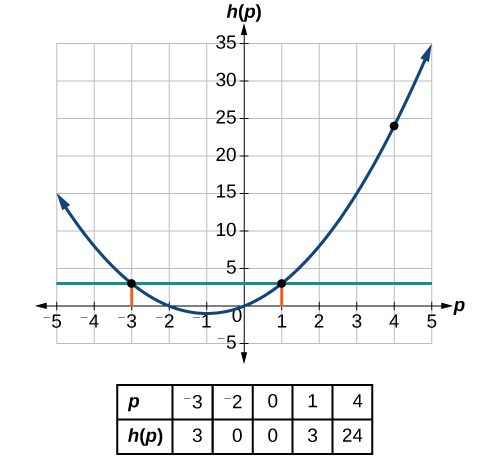
Given the function
solve
Some functions are defined by mathematical rules or procedures expressed in equation form. If it is possible to express the function output with a formula involving the input quantity, then we can define a function in algebraic form. For example, the equation
expresses a functional relationship between
and
We can rewrite it to decide if
is a function of
Given a function in equation form, write its algebraic formula.
Express the relationship
as a function
if possible.
To express the relationship in this form, we need to be able to write the relationship where
is a function of
which means writing it as
Therefore,
as a function of
is written as
Does the equation
represent a function with
as input and
as output? If so, express the relationship as a function
First we subtract
from both sides.
We now try to solve for
in this equation.
We get two outputs corresponding to the same input, so this relationship cannot be represented as a single function
If we graph both functions on a graphing calculator, we will get the upper and lower semicircles.
If
express
as a function of
Are there relationships expressed by an equation that do represent a function but that still cannot be represented by an algebraic formula?
*Yes, this can happen. For example, given the equation
if we want to express
as a function of
there is no simple algebraic formula involving only
that equals
However, each
does determine a unique value for
and there are mathematical procedures by which
can be found to any desired accuracy. In this case, we say that the equation gives an implicit (implied) rule for
as a function of
even though the formula cannot be written explicitly.*
As we saw above, we can represent functions in tables. Conversely, we can use information in tables to write functions, and we can evaluate functions using the tables. For example, how well do our pets recall the fond memories we share with them? There is an urban legend that a goldfish has a memory of 3 seconds, but this is just a myth. Goldfish can remember up to 3 months, while the beta fish has a memory of up to 5 months. And while a puppy’s memory span is no longer than 30 seconds, the adult dog can remember for 5 minutes. This is meager compared to a cat, whose memory span lasts for 16 hours.
The function that relates the type of pet to the duration of its memory span is more easily visualized with the use of a table. See [link].2
| Pet | Memory span in hours |
|---|---|
| Puppy | 0.008 |
| Adult dog | 0.083 |
| Cat | 16 |
| Goldfish | 2160 |
| Beta fish | 3600 |
At times, evaluating a function in table form may be more useful than using equations. Here let us call the function
The domain of the function is the type of pet and the range is a real number representing the number of hours the pet’s memory span lasts. We can evaluate the function
at the input value of “goldfish.” We would write
Notice that, to evaluate the function in table form, we identify the input value and the corresponding output value from the pertinent row of the table. The tabular form for function
seems ideally suited to this function, more so than writing it in paragraph or function form.
Given a function represented by a table, identify specific output and input values.
means determining the output value of the function
for the input value of
The table output value corresponding to
is 7, so
means identifying the input values,
that produce an output value of 6. [link] shows two solutions:
and
| 1 | 2 | 3 | 4 | 5 | |
| 8 | 6 | 7 | 6 | 8 |
When we input 2 into the function
our output is 6. When we input 4 into the function
our output is also 6.
Using [link], evaluate
Evaluating a function using a graph also requires finding the corresponding output value for a given input value, only in this case, we find the output value by looking at the graph. Solving a function equation using a graph requires finding all instances of the given output value on the graph and observing the corresponding input value(s).
locate the point on the curve where
then read the y-coordinate of that point. The point has coordinates
so
See [link]. 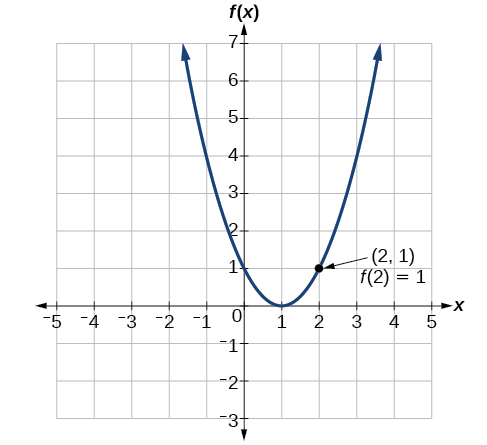
we find the output value
on the vertical axis. Moving horizontally along the line
we locate two points of the curve with output value
and
These points represent the two solutions to
or
This means
and
or when the input is
or
the output is
See [link]. 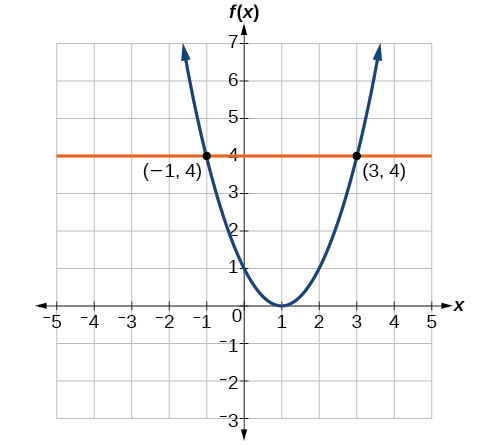
Using [link], solve
or
Some functions have a given output value that corresponds to two or more input values. For example, in the stock chart shown in [link] at the beginning of this chapter, the stock price was $1000 on five different dates, meaning that there were five different input values that all resulted in the same output value of $1000.
However, some functions have only one input value for each output value, as well as having only one output for each input. We call these functions one-to-one functions. As an example, consider a school that uses only letter grades and decimal equivalents, as listed in [link].
| Letter grade | Grade point average |
|---|---|
| A | 4.0 |
| B | 3.0 |
| C | 2.0 |
| D | 1.0 |
This grading system represents a one-to-one function because each letter input yields one particular grade-point average output and each grade-point average corresponds to one input letter.
To visualize this concept, let’s look again at the two simple functions sketched in [link](a) and [link](b). The function in part (a) shows a relationship that is not a one-to-one function because inputs
and
both give output
The function in part (b) shows a relationship that is a one-to-one function because each input is associated with a single output.
A one-to-one function is a function in which each output value corresponds to exactly one input value. There are no repeated x- or y-values.
Is the area of a circle a function of its radius? If yes, is the function one-to-one?
A circle of radius
has a unique area measure given by
so for any input,
there is only one output,
The area is a function of radius
If the function is one-to-one, the output value, the area, must correspond to a unique input value, the radius. Any area measure
is given by the formula
Because areas and radii are positive numbers, there is exactly one solution:
So the area of a circle is a one-to-one function of the circle’s radius.
a. yes, because each bank account has a single balance at any given time; b. no, because several bank account numbers may have the same balance; c. no, because the same output may correspond to more than one input.
As we have seen in some examples above, we can represent a function using a graph. Graphs display a great many input-output pairs in a small space. The visual information they provide often makes relationships easier to understand. By convention, graphs are typically constructed with the input values along the horizontal axis and the output values along the vertical axis.
The most common graphs name the input value
and the output value
and we say
is a function of
or
when the function is named
The graph of the function is the set of all points
in the plane that satisfies the equation
If the function is defined for only a few input values, then the graph of the function consists of only a few points, where the x-coordinate of each point is an input value and the y-coordinate of each point is the corresponding output value. For example, the black dots on the graph in [link] tell us that
and
However, the set of all points
satisfying
is a curve. The curve shown includes
and
because the curve passes through those points.
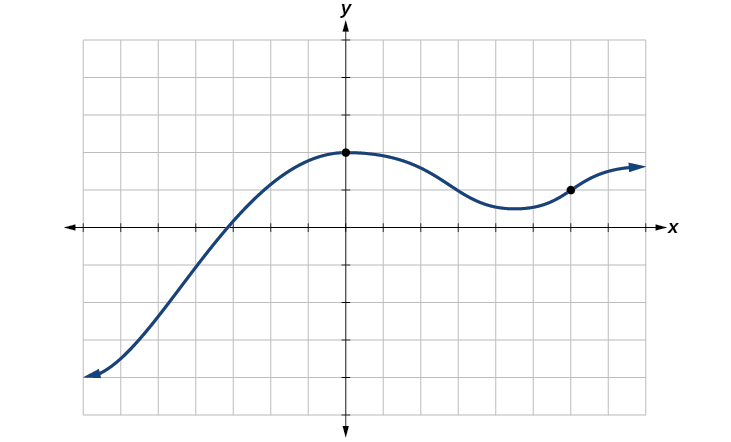
The vertical line test can be used to determine whether a graph represents a function. If we can draw any vertical line that intersects a graph more than once, then the graph does not define a function because a function has only one output value for each input value. See [link].

Given a graph, use the vertical line test to determine if the graph represents a function.
If any vertical line intersects a graph more than once, the relation represented by the graph is not a function. Notice that any vertical line would pass through only one point of the two graphs shown in parts (a) and (b) of [link]. From this we can conclude that these two graphs represent functions. The third graph does not represent a function because, at most x-values, a vertical line would intersect the graph at more than one point, as shown in [link].
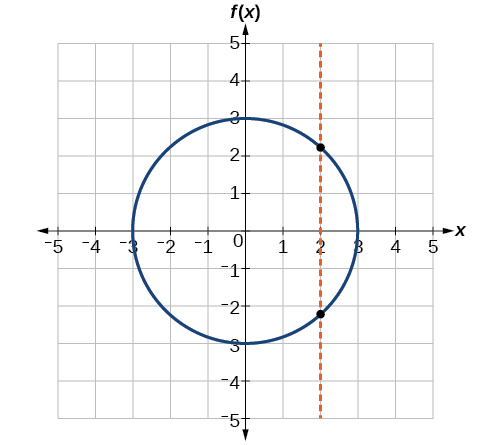
Does the graph in [link] represent a function?
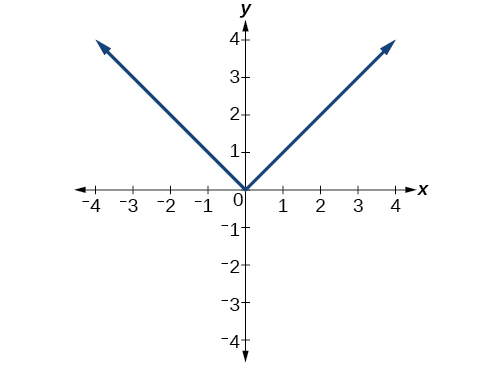
yes
Once we have determined that a graph defines a function, an easy way to determine if it is a one-to-one function is to use the horizontal line test. Draw horizontal lines through the graph. If any horizontal line intersects the graph more than once, then the graph does not represent a one-to-one function.
Given a graph of a function, use the horizontal line test to determine if the graph represents a one-to-one function.
Consider the functions shown in [link](a) and [link](b). Are either of the functions one-to-one?
The function in [link](a) is not one-to-one. The horizontal line shown in [link] intersects the graph of the function at two points (and we can even find horizontal lines that intersect it at three points.)
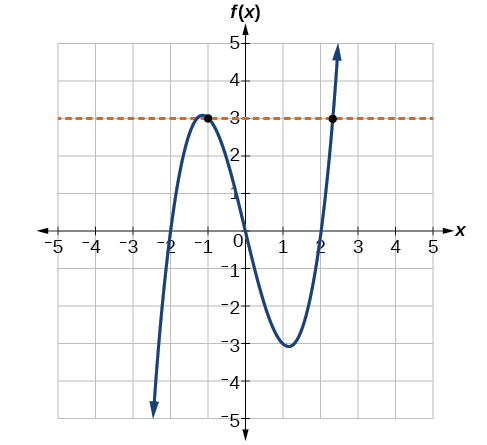
The function in [link](b) is one-to-one. Any horizontal line will intersect a diagonal line at most once.
Is the graph shown in [link] one-to-one?
No, because it does not pass the horizontal line test.
In this text, we will be exploring functions—the shapes of their graphs, their unique characteristics, their algebraic formulas, and how to solve problems with them. When learning to read, we start with the alphabet. When learning to do arithmetic, we start with numbers. When working with functions, it is similarly helpful to have a base set of building-block elements. We call these our “toolkit functions,” which form a set of basic named functions for which we know the graph, formula, and special properties. Some of these functions are programmed to individual buttons on many calculators. For these definitions we will use
as the input variable and
as the output variable.
We will see these toolkit functions, combinations of toolkit functions, their graphs, and their transformations frequently throughout this book. It will be very helpful if we can recognize these toolkit functions and their features quickly by name, formula, graph, and basic table properties. The graphs and sample table values are included with each function shown in [link].
| Toolkit Functions | ||
|---|---|---|
| Name | Function | Graph |
| Constant | where is a constant |
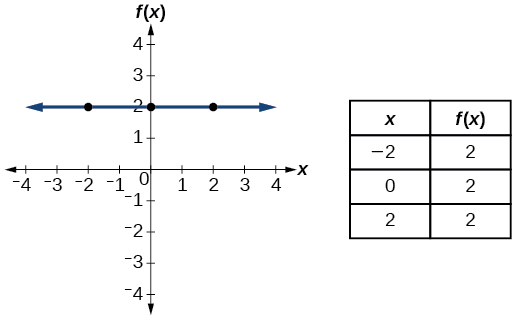
|
| Identity |
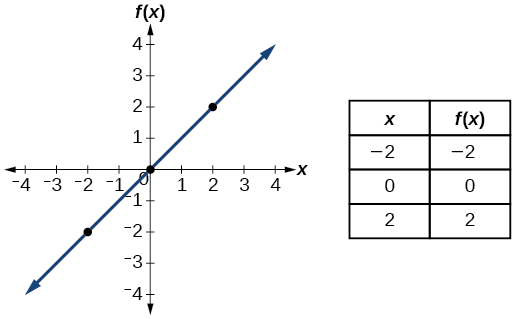
|
|
| Absolute value |
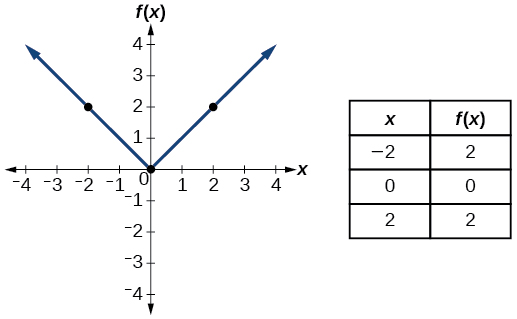
|
|
| Quadratic |
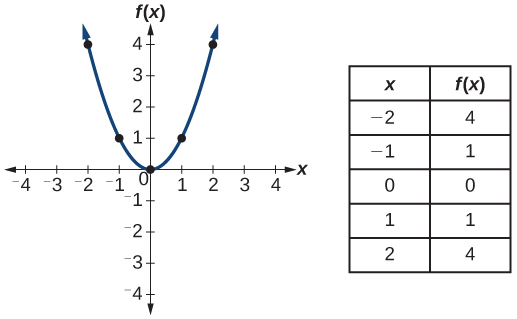
|
|
| Cubic |
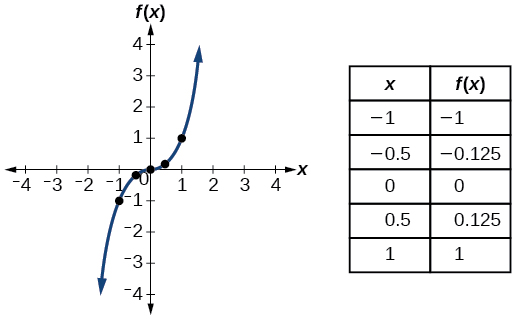
|
|
| Reciprocal |
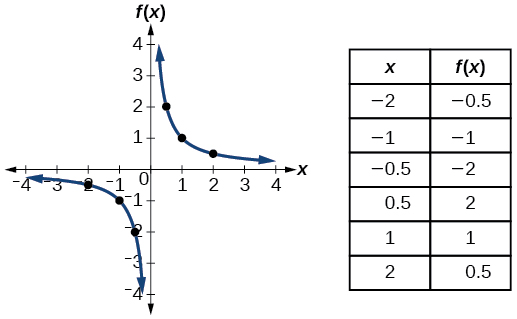
|
|
| Reciprocal squared |
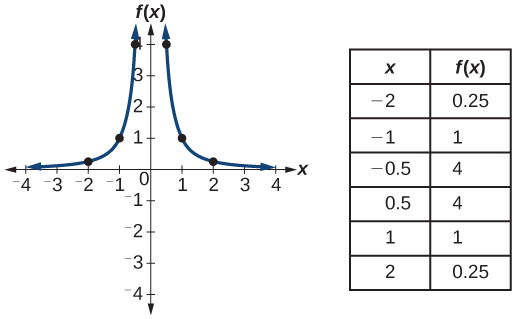
|
|
| Square root |
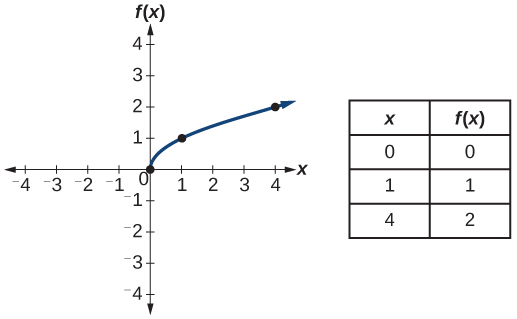
|
|
| Cube root |
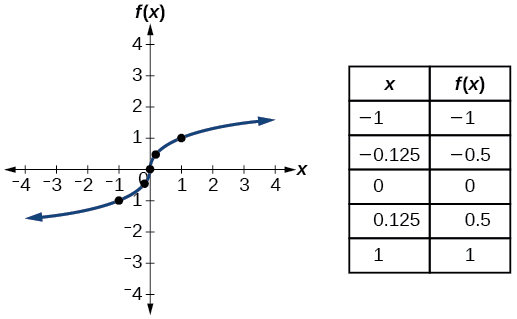
|
|
Access the following online resources for additional instruction and practice with functions.
| Constant function | whereis a constant |
| Identity function | |
| Absolute value function | |
| Quadratic function | |
| Cubic function | |
| Reciprocal function | |
| Reciprocal squared function | |
| Square root function | |
| Cube root function |
What is the difference between a relation and a function?
A relation is a set of ordered pairs. A function is a special kind of relation in which no two ordered pairs have the same first coordinate.
What is the difference between the input and the output of a function?
Why does the vertical line test tell us whether the graph of a relation represents a function?
When a vertical line intersects the graph of a relation more than once, that indicates that for that input there is more than one output. At any particular input value, there can be only one output if the relation is to be a function.
How can you determine if a relation is a one-to-one function?
Why does the horizontal line test tell us whether the graph of a function is one-to-one?
When a horizontal line intersects the graph of a function more than once, that indicates that for that output there is more than one input. A function is one-to-one if each output corresponds to only one input.
For the following exercises, determine whether the relation represents a function.
function
For the following exercises, determine whether the relation represents
as a function of
function
function
function
function
function
function
function
function
not a function
For the following exercises, evaluate the function
at the indicated values
Given the function
simplify
Given the function
simplify
Given the function
Given the function
a.
b.
Given the function
Given the function
a.
b.
or
Given the function
Consider the relationship
a.
b.
c.
For the following exercises, use the vertical line test to determine which graphs show relations that are functions.
not a function
function
function
function
function
function
Given the following graph,
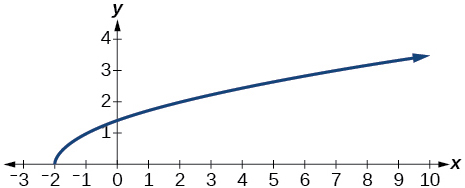
Given the following graph,
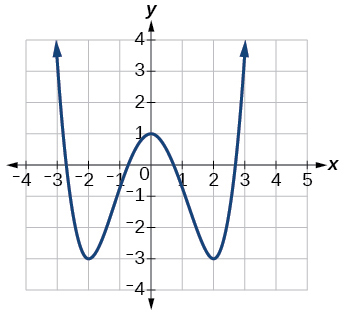
a.
b.
or
Given the following graph,
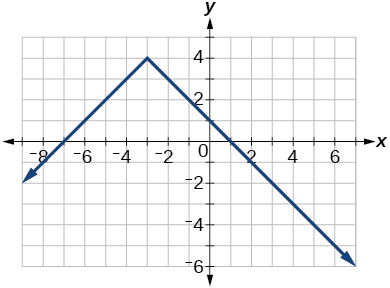
For the following exercises, determine if the given graph is a one-to-one function.
not a function so it is also not a one-to-one function
one-to- one function
function, but not one-to-one
For the following exercises, determine whether the relation represents a function.
function
For the following exercises, determine if the relation represented in table form represents
as a function of
| 5 | 10 | 15 | |
| 3 | 8 | 14 |
function
| 5 | 10 | 15 | |
| 3 | 8 | 8 |
| 5 | 10 | 10 | |
| 3 | 8 | 14 |
not a function
For the following exercises, use the function
represented in [link].
| | | | 0 | 74 | | 1 | 28 | | 2 | 1 | | 3 | 53 | | 4 | 56 | | 5 | 3 | | 6 | 36 | | 7 | 45 | | 8 | 14 | | 9 | 47 |
Evaluate
Solve
For the following exercises, evaluate the function
at the values
and
For the following exercises, evaluate the expressions, given functions
and
20
For the following exercises, graph
on the given viewing window. Determine the corresponding range for each viewing window. Show each graph.
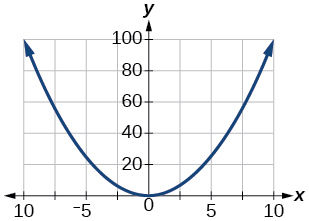
For the following exercises, graph
on the given viewing window. Determine the corresponding range for each viewing window. Show each graph.
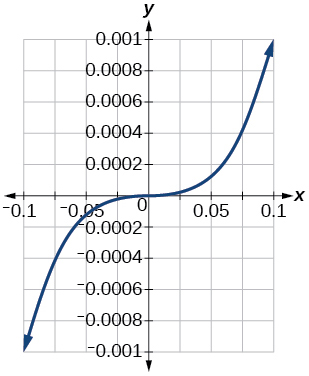
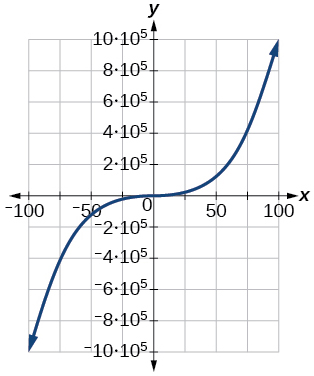
For the following exercises, graph
on the given viewing window. Determine the corresponding range for each viewing window. Show each graph.
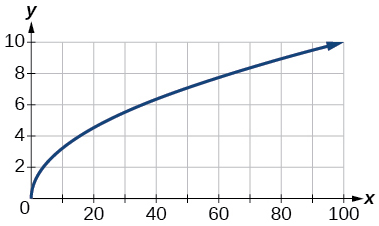
For the following exercises, graph
on the given viewing window. Determine the corresponding range for each viewing window. Show each graph.
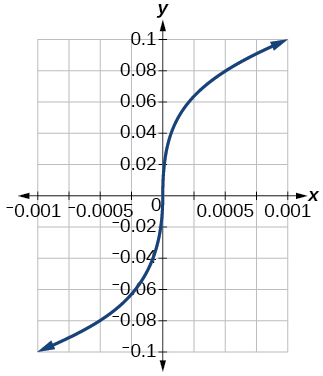
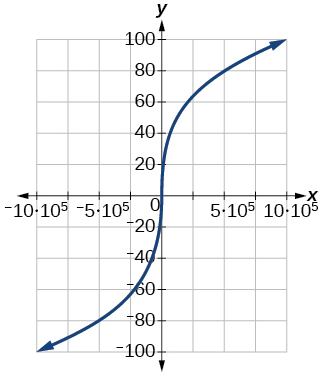
The amount of garbage,
produced by a city with population
is given by
is measured in tons per week, and
is measured in thousands of people.
The number of cubic yards of dirt,
needed to cover a garden with area
square feet is given by
a.
b. The number of cubic yards of dirt required for a garden of 100 square feet is 1.
Let
be the number of ducks in a lake
years after 1990. Explain the meaning of each statement:
Let
be the height above ground, in feet, of a rocket
seconds after launching. Explain the meaning of each statement:
a. The height of a rocket above ground after 1 second is 200 ft. b. the height of a rocket above ground after 2 seconds is 350 ft.
Show that the function
is not one-to-one.

You can also download for free at http://cnx.org/contents/13ac107a-f15f-49d2-97e8-60ab2e3b519c@11.1
Attribution: